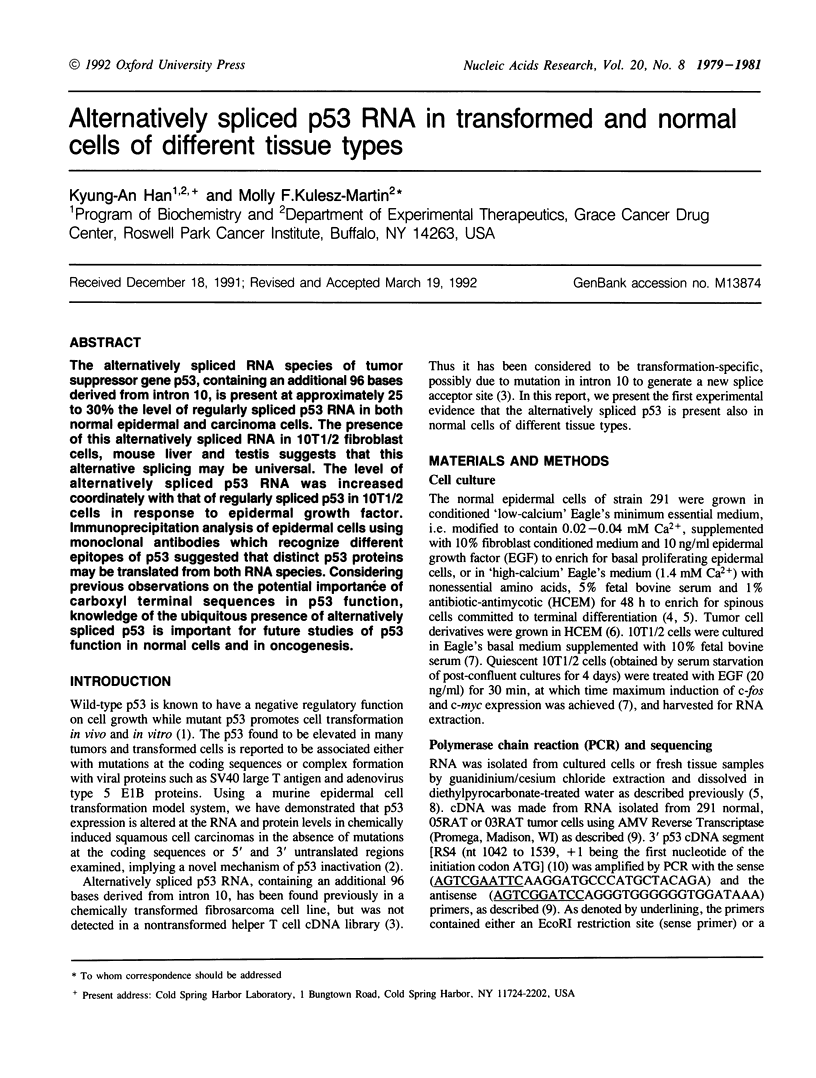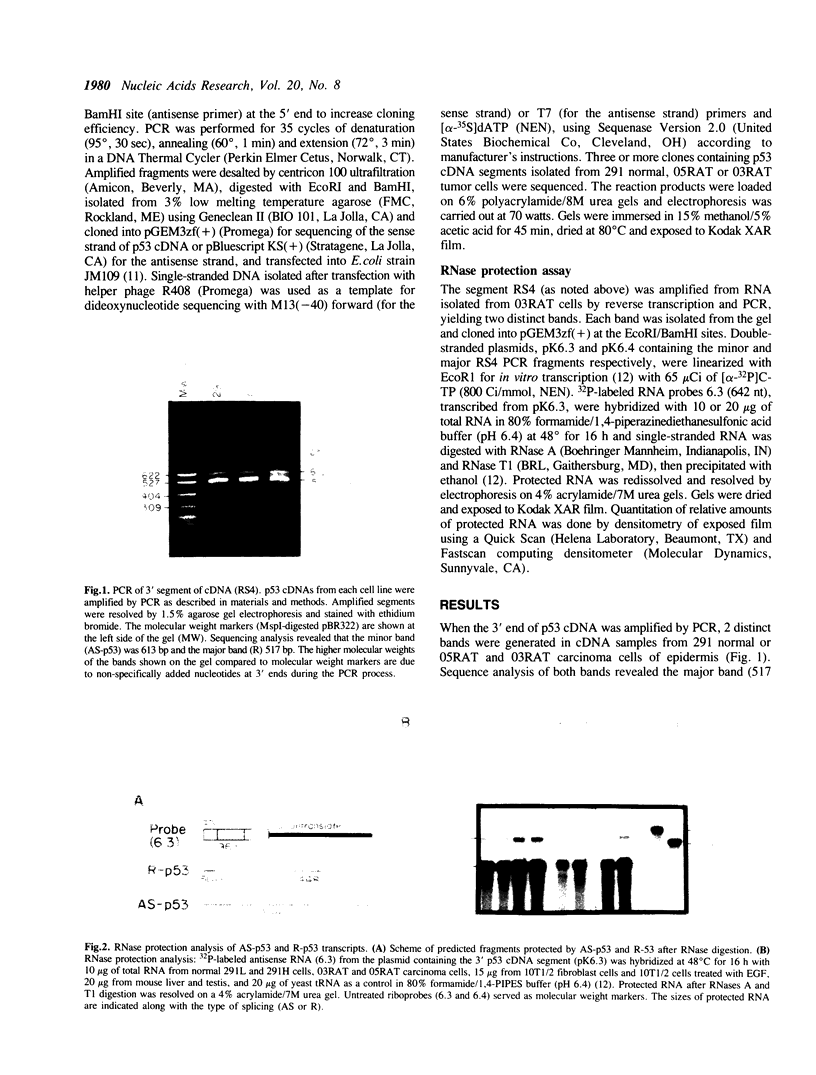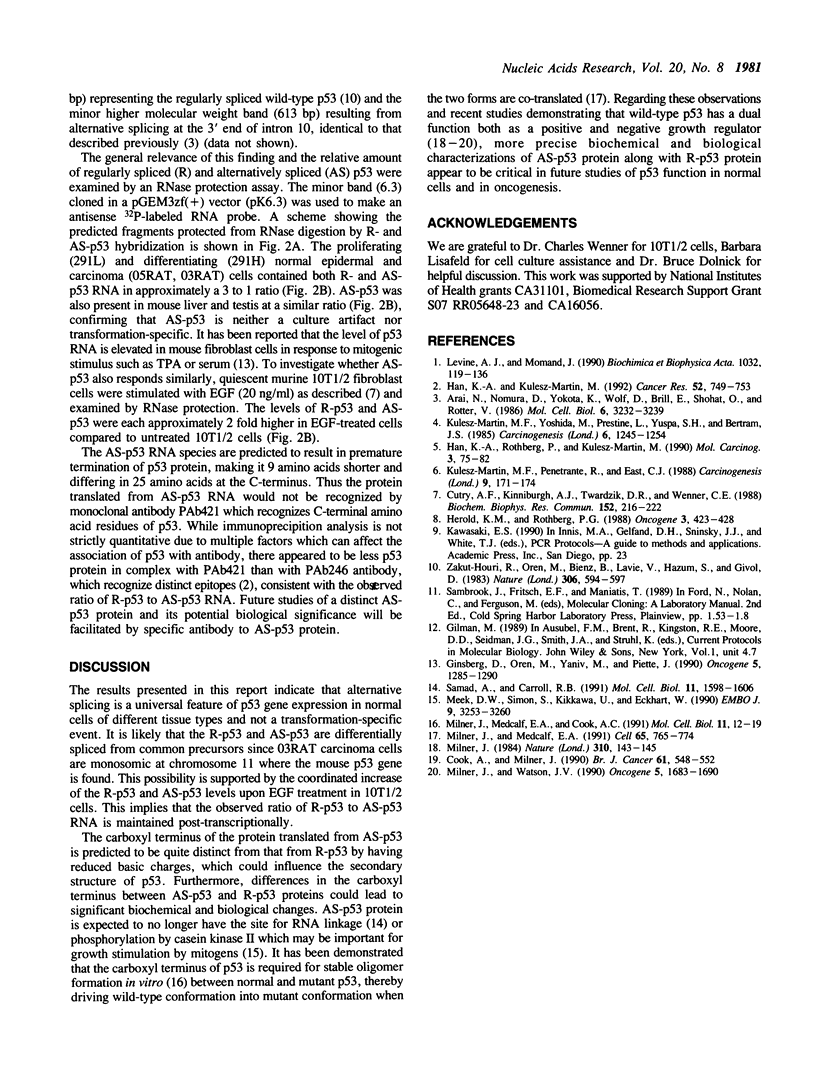Abstract
The alternatively spliced RNA species of tumor suppressor gene p53, containing an additional 96 bases derived from intron 10, is present at approximately 25 to 30% the level of regularly spliced p53 RNA in both normal epidermal and carcinoma cells. The presence of this alternatively spliced RNA in 10T1/2 fibroblast cells, mouse liver and testis suggests that this alternative splicing may be universal. The level of alternatively spliced p53 RNA was increased coordinately with that of regularly spliced p53 in 10T1/2 cells in response to epidermal growth factor. Immunoprecipitation analysis of epidermal cells using monoclonal antibodies which recognize different epitopes of p53 suggested that distinct p53 proteins may be translated from both RNA species. Considering previous observations on the potential importance of carboxyl terminal sequences in p53 function, knowledge of the ubiquitous presence of alternatively spliced p53 is important for future studies of p53 function in normal cells and in oncogenesis.
Full text
PDF


Images in this article
Selected References
These references are in PubMed. This may not be the complete list of references from this article.
- Arai N., Nomura D., Yokota K., Wolf D., Brill E., Shohat O., Rotter V. Immunologically distinct p53 molecules generated by alternative splicing. Mol Cell Biol. 1986 Sep;6(9):3232–3239. doi: 10.1128/mcb.6.9.3232. [DOI] [PMC free article] [PubMed] [Google Scholar]
- Cook A., Milner J. Evidence for allosteric variants of wild-type p53, a tumour suppressor protein. Br J Cancer. 1990 Apr;61(4):548–552. doi: 10.1038/bjc.1990.123. [DOI] [PMC free article] [PubMed] [Google Scholar]
- Cutry A. F., Kinniburgh A. J., Twardzik D. R., Wenner C. E. Transforming growth factor alpha (TGF alpha) induction of C-FOS and C-MYC expression in C3H 10T1/2 cells. Biochem Biophys Res Commun. 1988 Apr 15;152(1):216–222. doi: 10.1016/s0006-291x(88)80702-2. [DOI] [PubMed] [Google Scholar]
- Ginsberg D., Oren M., Yaniv M., Piette J. Protein-binding elements in the promoter region of the mouse p53 gene. Oncogene. 1990 Sep;5(9):1285–1290. [PubMed] [Google Scholar]
- Han K. A., Kulesz-Martin M. F. Altered expression of wild-type p53 tumor suppressor gene during murine epithelial cell transformation. Cancer Res. 1992 Feb 1;52(3):749–753. [PubMed] [Google Scholar]
- Han K. A., Rothberg P., Kulesz-Martin M. Altered levels of endogenous retrovirus-like sequence (VL30) RNA during mouse epidermal cell carcinogenesis. Mol Carcinog. 1990;3(2):75–82. doi: 10.1002/mc.2940030205. [DOI] [PubMed] [Google Scholar]
- Herold K. M., Rothberg P. G. Evidence for a labile intermediate in the butyrate induced reduction of the level of c-myc RNA in SW837 rectal carcinoma cells. Oncogene. 1988 Oct;3(4):423–428. [PubMed] [Google Scholar]
- Kulesz-Martin M. F., Penetrante R., East C. J. Benign and malignant tumor stages in a mouse keratinocyte line treated with 7,12-dimethylbenz[a]anthracene in vitro. Carcinogenesis. 1988 Jan;9(1):171–174. doi: 10.1093/carcin/9.1.171. [DOI] [PubMed] [Google Scholar]
- Kulesz-Martin M., Yoshida M. A., Prestine L., Yuspa S. H., Bertram J. S. Mouse cell clones for improved quantitation of carcinogen-induced altered differentiation. Carcinogenesis. 1985 Sep;6(9):1245–1254. doi: 10.1093/carcin/6.9.1245. [DOI] [PubMed] [Google Scholar]
- Levine A. J., Momand J. Tumor suppressor genes: the p53 and retinoblastoma sensitivity genes and gene products. Biochim Biophys Acta. 1990 Jun 1;1032(1):119–136. doi: 10.1016/0304-419x(90)90015-s. [DOI] [PubMed] [Google Scholar]
- Meek D. W., Simon S., Kikkawa U., Eckhart W. The p53 tumour suppressor protein is phosphorylated at serine 389 by casein kinase II. EMBO J. 1990 Oct;9(10):3253–3260. doi: 10.1002/j.1460-2075.1990.tb07524.x. [DOI] [PMC free article] [PubMed] [Google Scholar]
- Milner J. Different forms of p53 detected by monoclonal antibodies in non-dividing and dividing lymphocytes. Nature. 1984 Jul 12;310(5973):143–145. doi: 10.1038/310143a0. [DOI] [PubMed] [Google Scholar]
- Milner J., Medcalf E. A., Cook A. C. Tumor suppressor p53: analysis of wild-type and mutant p53 complexes. Mol Cell Biol. 1991 Jan;11(1):12–19. doi: 10.1128/mcb.11.1.12. [DOI] [PMC free article] [PubMed] [Google Scholar]
- Milner J., Medcalf E. A. Cotranslation of activated mutant p53 with wild type drives the wild-type p53 protein into the mutant conformation. Cell. 1991 May 31;65(5):765–774. doi: 10.1016/0092-8674(91)90384-b. [DOI] [PubMed] [Google Scholar]
- Milner J., Watson J. V. Addition of fresh medium induces cell cycle and conformation changes in p53, a tumour suppressor protein. Oncogene. 1990 Nov;5(11):1683–1690. [PubMed] [Google Scholar]
- Samad A., Carroll R. B. The tumor suppressor p53 is bound to RNA by a stable covalent linkage. Mol Cell Biol. 1991 Mar;11(3):1598–1606. doi: 10.1128/mcb.11.3.1598. [DOI] [PMC free article] [PubMed] [Google Scholar]
- Zakut-Houri R., Oren M., Bienz B., Lavie V., Hazum S., Givol D. A single gene and a pseudogene for the cellular tumour antigen p53. Nature. 1983 Dec 8;306(5943):594–597. doi: 10.1038/306594a0. [DOI] [PubMed] [Google Scholar]




